
TD SYNNEX (SNX)
We’re wary of TD SYNNEX. Its sales have underperformed and its low returns on capital show it has few growth opportunities.― StockStory Analyst Team
1. News
2. Summary
Why TD SYNNEX Is Not Exciting
Serving as the crucial middleman in the technology supply chain, TD SYNNEX (NYSE:SNX) is a global technology distributor that connects thousands of IT manufacturers with resellers, helping businesses access hardware, software, and technology solutions.
- Incremental sales over the last five years were less profitable as its earnings per share were flat while its revenue grew
- Ability to fund investments or reward shareholders with increased buybacks or dividends is restricted by its weak free cash flow margin of 1.2% for the last five years
- The good news is that its unparalleled revenue scale of $60.97 billion gives it an edge in distribution


TD SYNNEX is skating on thin ice. We believe there are better businesses elsewhere.
Why There Are Better Opportunities Than TD SYNNEX
High Quality
Investable
Underperform
Why There Are Better Opportunities Than TD SYNNEX
TD SYNNEX’s stock price of $153.00 implies a valuation ratio of 10.8x forward P/E. Yes, this valuation multiple is lower than that of other business services peers, but we’ll remind you that you often get what you pay for.
We’d rather pay up for companies with elite fundamentals than get a bargain on weak ones. Cheap stocks can be value traps, and as their performance deteriorates, they will stay cheap or get even cheaper.
3. TD SYNNEX (SNX) Research Report: Q3 CY2025 Update
IT distribution giant TD SYNNEX (NYSE:SNX) reported Q3 CY2025 results topping the market’s revenue expectations, with sales up 6.6% year on year to $15.65 billion. On top of that, next quarter’s revenue guidance ($16.9 billion at the midpoint) was surprisingly good and 6% above what analysts were expecting. Its non-GAAP profit of $3.58 per share was 17.5% above analysts’ consensus estimates.
TD SYNNEX (SNX) Q3 CY2025 Highlights:
- Revenue: $15.65 billion vs analyst estimates of $15.12 billion (6.6% year-on-year growth, 3.5% beat)
- Adjusted EPS: $3.58 vs analyst estimates of $3.05 (17.5% beat)
- Adjusted EBITDA: $504.2 million vs analyst estimates of $443.9 million (3.2% margin, 13.6% beat)
- Revenue Guidance for Q4 CY2025 is $16.9 billion at the midpoint, above analyst estimates of $15.94 billion
- Adjusted EPS guidance for Q4 CY2025 is $3.70 at the midpoint, above analyst estimates of $3.33
- Operating Margin: 2.5%, in line with the same quarter last year
- Free Cash Flow Margin: 1.4%, similar to the same quarter last year
- Market Capitalization: $12.4 billion
Company Overview
Serving as the crucial middleman in the technology supply chain, TD SYNNEX (NYSE:SNX) is a global technology distributor that connects thousands of IT manufacturers with resellers, helping businesses access hardware, software, and technology solutions.
The company operates as a massive technology wholesaler, maintaining relationships with approximately 2,500 technology manufacturers including industry giants like Apple, Microsoft, Cisco, and IBM. This extensive network allows TD SYNNEX to offer a comprehensive catalog of over 200,000 technology products to more than 150,000 reseller customers worldwide.
TD SYNNEX's business is organized into two main portfolios. The Endpoint Solutions portfolio handles personal computing devices, mobile phones, and printers that end-users directly interact with. The Advanced Solutions portfolio focuses on infrastructure technology like servers, networking equipment, security systems, and cloud technologies.
Beyond simple distribution, TD SYNNEX provides value-added services throughout the IT supply chain. For example, a small business IT provider might purchase server equipment, networking gear, and software licenses through TD SYNNEX, along with integration services to ensure everything works together before delivery to their client. The company's engineers design custom server and storage solutions, while its logistics experts manage everything from warehouse operations to returns processing.
TD SYNNEX also offers financial services to its reseller customers, including credit terms, leasing options, and floor plan financing, which helps these businesses manage cash flow while serving their end customers. Additionally, the company provides cloud services that help businesses transition to hosted environments and navigate complex technologies like artificial intelligence and cybersecurity.
With distribution centers across the Americas, Europe, and Asia-Pacific regions, TD SYNNEX maintains a global footprint that allows it to serve as a single source for technology products worldwide. The company's highly automated distribution processes utilize technologies like robotic automation and real-time inventory tracking to ensure efficient and accurate order fulfillment.
4. IT Distribution & Solutions
IT Distribution & Solutions will be buoyed by the increasing complexity of IT ecosystems, rising cloud adoption, and demand for cybersecurity solutions. Enterprises are less likely than ever to embark on these complicated journeys solo, and companies in the sector boast expertise and scale in these areas. However, cloud migration also means less need for hardware, which could dent demand for large portions of the product portfolio and hurt margins. Additionally, planning for potentially supply chain disruptions is ongoing, as the COVID-19 pandemic showed how damaging a pause in global trade could be in areas like semiconductor procurement.
TD SYNNEX competes with other major IT distributors including Arrow Electronics (NYSE: ARW), Ingram Micro (privately held), and ScanSource (NASDAQ: SCSC), along with various regional distributors across its global markets.
5. Revenue Growth
Examining a company’s long-term performance can provide clues about its quality. Any business can put up a good quarter or two, but the best consistently grow over the long haul.
With $60.97 billion in revenue over the past 12 months, TD SYNNEX is a behemoth in the business services sector and benefits from economies of scale, giving it an edge in distribution. This also enables it to gain more leverage on its fixed costs than smaller competitors and the flexibility to offer lower prices.
As you can see below, TD SYNNEX grew its sales at an incredible 24.4% compounded annual growth rate over the last five years. This shows it had high demand, a useful starting point for our analysis.
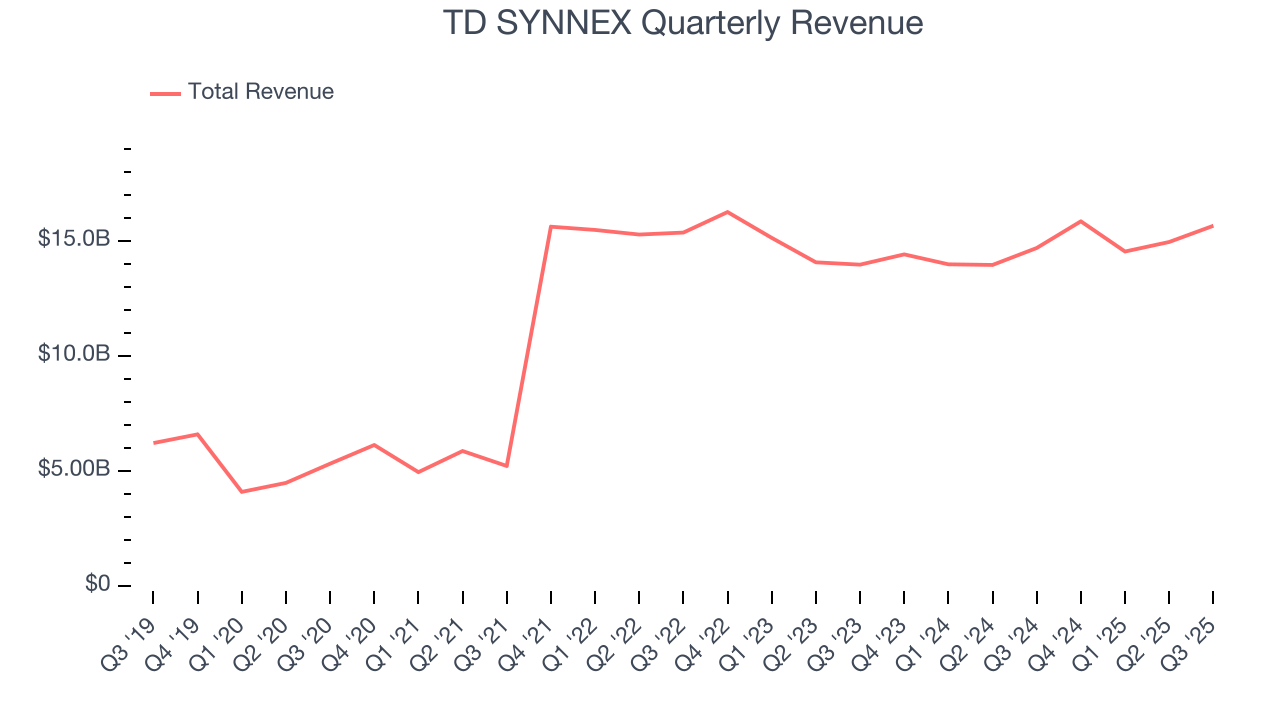
Long-term growth is the most important, but within business services, a half-decade historical view may miss new innovations or demand cycles. TD SYNNEX’s recent performance shows its demand has slowed significantly as its annualized revenue growth of 1.3% over the last two years was well below its five-year trend. 
This quarter, TD SYNNEX reported year-on-year revenue growth of 6.6%, and its $15.65 billion of revenue exceeded Wall Street’s estimates by 3.5%. Company management is currently guiding for a 6.7% year-on-year increase in sales next quarter.
Looking further ahead, sell-side analysts expect revenue to grow 2.2% over the next 12 months, similar to its two-year rate. This projection doesn't excite us and indicates its newer products and services will not lead to better top-line performance yet.
6. Operating Margin
Operating margin is a key measure of profitability. Think of it as net income - the bottom line - excluding the impact of taxes and interest on debt, which are less connected to business fundamentals.
TD SYNNEX’s operating margin might fluctuated slightly over the last 12 months but has generally stayed the same, averaging 2% over the last five years. This profitability was inadequate for a business services business and caused by its suboptimal cost structure.
Analyzing the trend in its profitability, TD SYNNEX’s operating margin might fluctuated slightly but has generally stayed the same over the last five years. This raises questions about the company’s expense base because its revenue growth should have given it leverage on its fixed costs, resulting in better economies of scale and profitability.
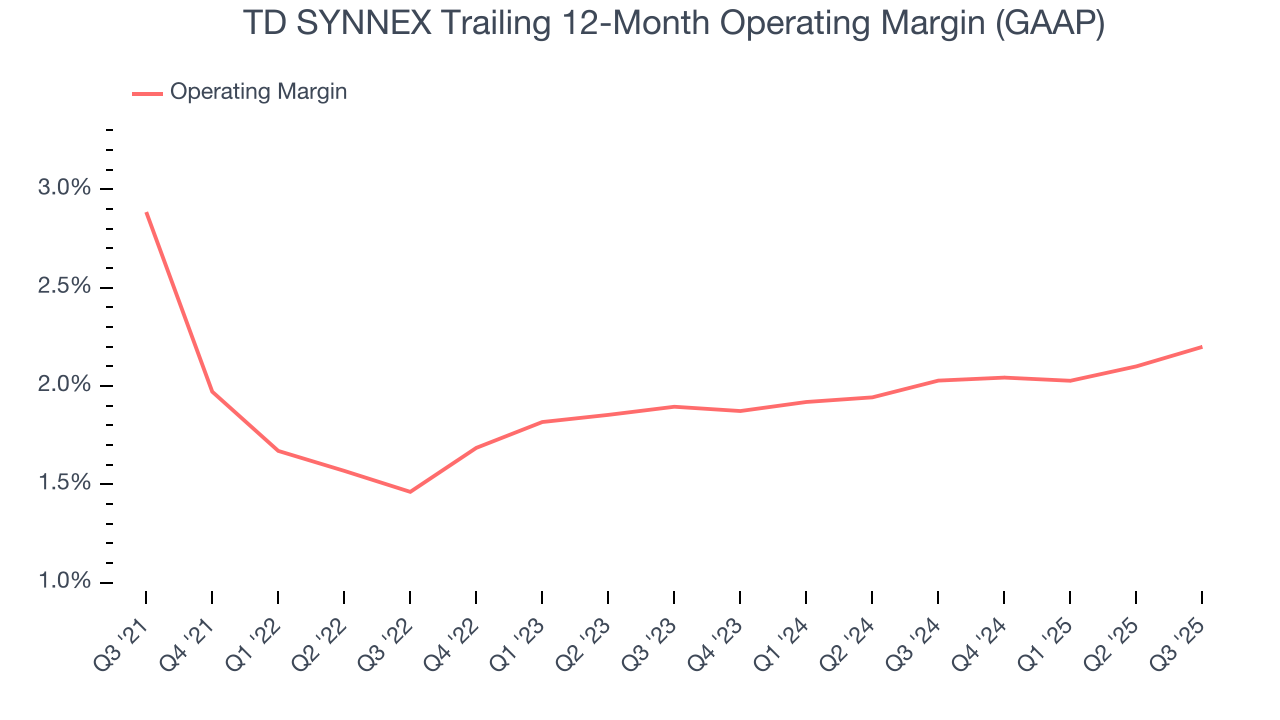
In Q3, TD SYNNEX generated an operating margin profit margin of 2.5%, in line with the same quarter last year. This indicates the company’s overall cost structure has been relatively stable.
7. Earnings Per Share
Revenue trends explain a company’s historical growth, but the long-term change in earnings per share (EPS) points to the profitability of that growth – for example, a company could inflate its sales through excessive spending on advertising and promotions.
TD SYNNEX’s flat EPS over the last five years was below its 24.4% annualized revenue growth. However, its operating margin didn’t change during this time, telling us that non-fundamental factors such as interest and taxes affected its ultimate earnings.
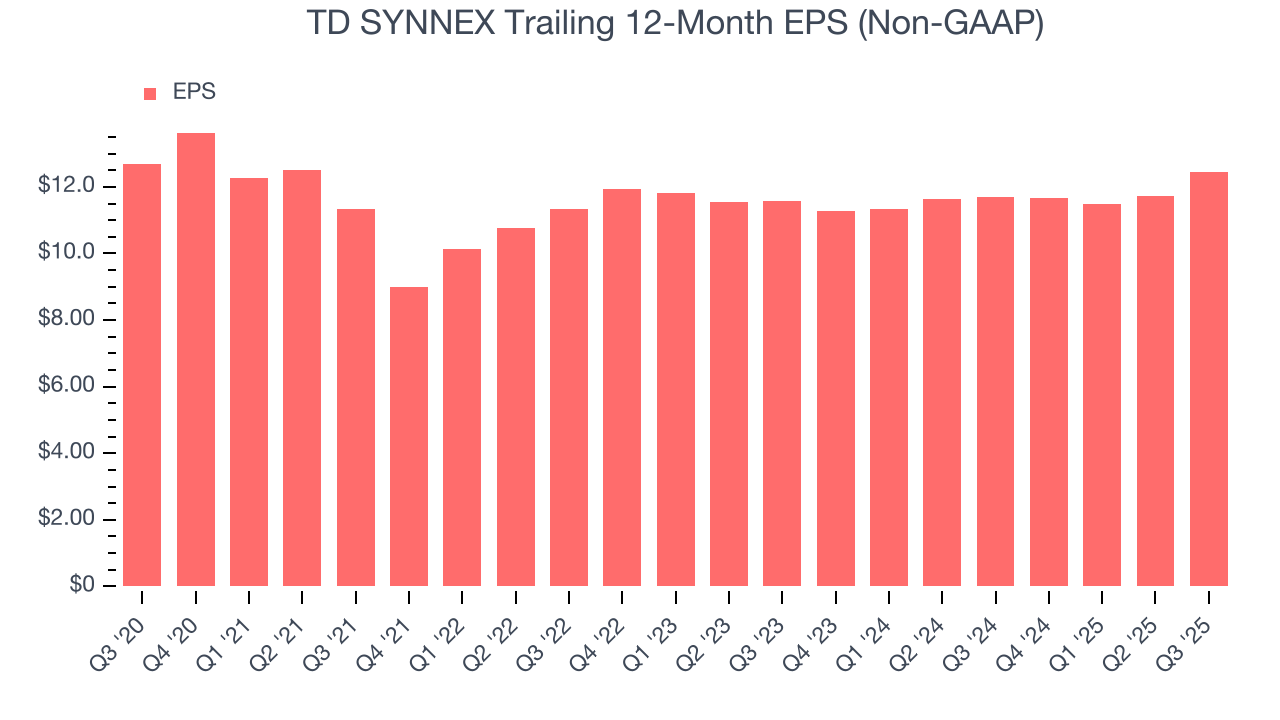
Like with revenue, we analyze EPS over a more recent period because it can provide insight into an emerging theme or development for the business.
For TD SYNNEX, its two-year annual EPS growth of 3.7% was higher than its five-year trend. Accelerating earnings growth is almost always an encouraging data point.
In Q3, TD SYNNEX reported adjusted EPS of $3.58, up from $2.86 in the same quarter last year. This print easily cleared analysts’ estimates, and shareholders should be content with the results. Over the next 12 months, Wall Street expects TD SYNNEX’s full-year EPS of $12.46 to grow 5.7%.
8. Cash Is King
If you’ve followed StockStory for a while, you know we emphasize free cash flow. Why, you ask? We believe that in the end, cash is king, and you can’t use accounting profits to pay the bills.
TD SYNNEX has shown poor cash profitability over the last five years, giving the company limited opportunities to return capital to shareholders. Its free cash flow margin averaged 1.2%, lousy for a business services business.
Taking a step back, we can see that TD SYNNEX’s margin dropped by 1.2 percentage points during that time. Almost any movement in the wrong direction is undesirable because of its already low cash conversion. If the trend continues, it could signal it’s in the middle of an investment cycle.
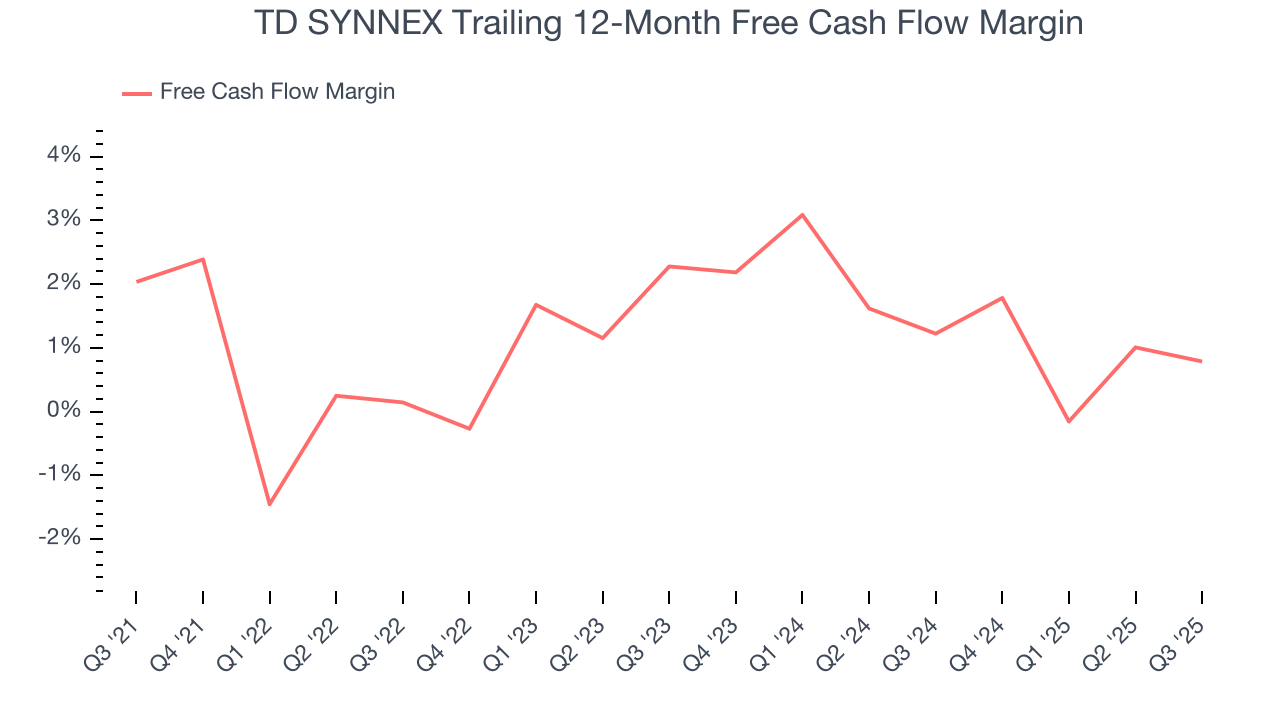
TD SYNNEX’s free cash flow clocked in at $213.9 million in Q3, equivalent to a 1.4% margin. This cash profitability was in line with the comparable period last year and its five-year average.
9. Return on Invested Capital (ROIC)
EPS and free cash flow tell us whether a company was profitable while growing its revenue. But was it capital-efficient? Enter ROIC, a metric showing how much operating profit a company generates relative to the money it has raised (debt and equity).
TD SYNNEX historically did a mediocre job investing in profitable growth initiatives. Its five-year average ROIC was 9.7%, somewhat low compared to the best business services companies that consistently pump out 25%+.
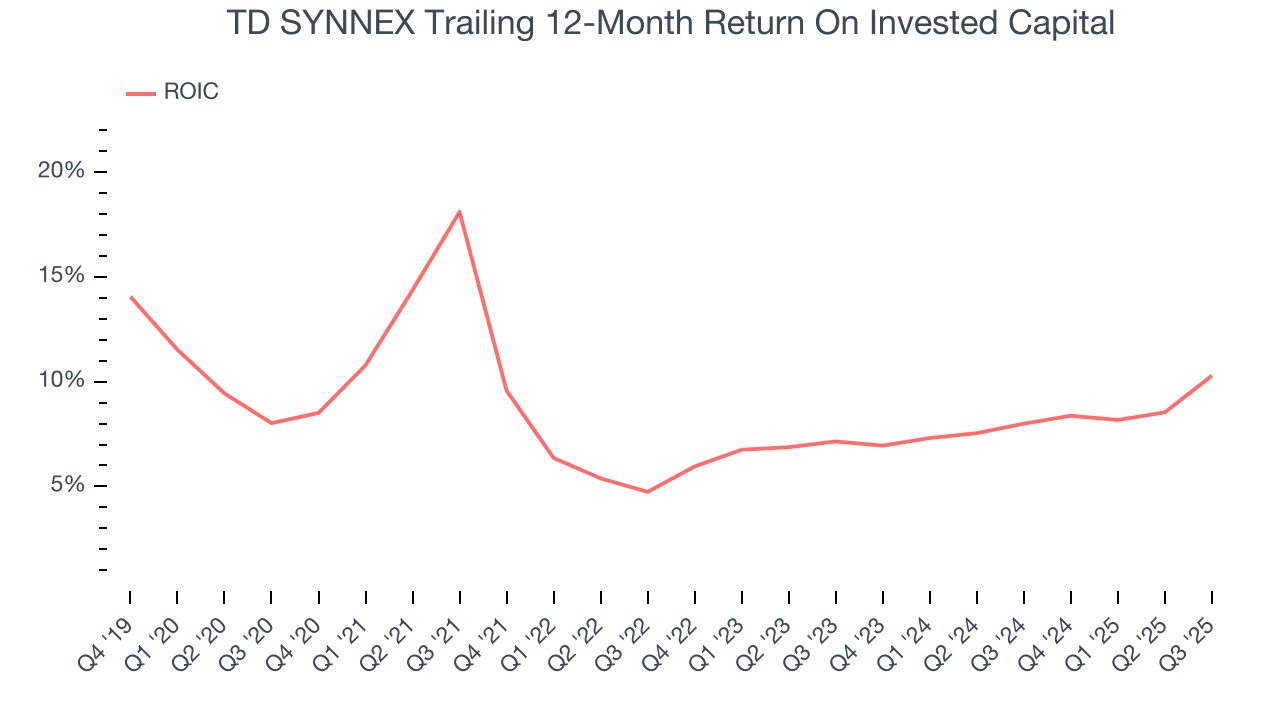
We like to invest in businesses with high returns, but the trend in a company’s ROIC is what often surprises the market and moves the stock price. Over the last few years, TD SYNNEX’s ROIC averaged 2.3 percentage point decreases each year. Paired with its already low returns, these declines suggest its profitable growth opportunities are few and far between.
10. Balance Sheet Assessment
TD SYNNEX reported $874.4 million of cash and $4.24 billion of debt on its balance sheet in the most recent quarter. As investors in high-quality companies, we primarily focus on two things: 1) that a company’s debt level isn’t too high and 2) that its interest payments are not excessively burdening the business.
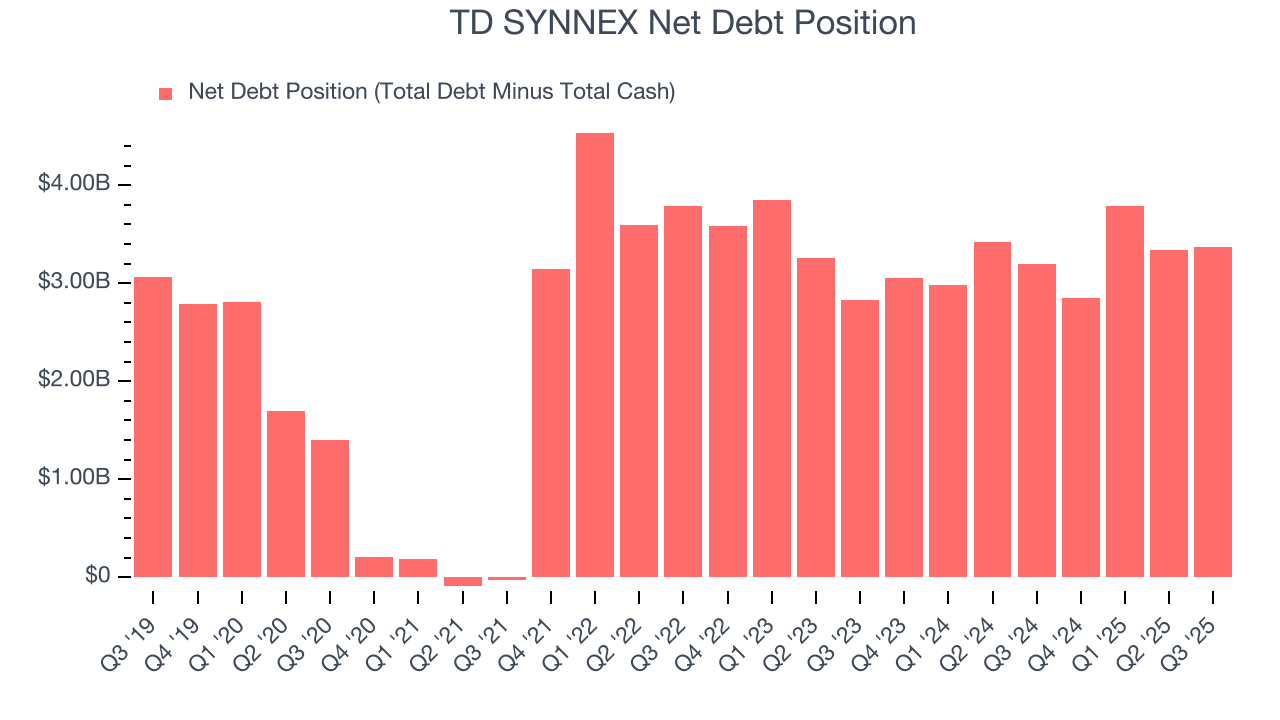
With $1.83 billion of EBITDA over the last 12 months, we view TD SYNNEX’s 1.8× net-debt-to-EBITDA ratio as safe. We also see its $133.9 million of annual interest expenses as appropriate. The company’s profits give it plenty of breathing room, allowing it to continue investing in growth initiatives.
11. Key Takeaways from TD SYNNEX’s Q3 Results
It was good to see TD SYNNEX beat analysts’ EPS expectations this quarter. We were also excited its EPS guidance for next quarter outperformed Wall Street’s estimates by a wide margin. Zooming out, we think this was a good print with some key areas of upside. The stock traded up 1.7% to $152.84 immediately after reporting.
12. Is Now The Time To Buy TD SYNNEX?
Updated: December 24, 2025 at 11:39 PM EST
Before making an investment decision, investors should account for TD SYNNEX’s business fundamentals and valuation in addition to what happened in the latest quarter.
TD SYNNEX’s business quality ultimately falls short of our standards. Although its revenue growth was exceptional over the last five years, it’s expected to deteriorate over the next 12 months and its weak EPS growth over the last five years shows it’s failed to produce meaningful profits for shareholders. And while the company’s scale makes it a trusted partner with negotiating leverage, the downside is its low free cash flow margins give it little breathing room.
TD SYNNEX’s P/E ratio based on the next 12 months is 10.8x. While this valuation is fair, the upside isn’t great compared to the potential downside. We're fairly confident there are better investments elsewhere.
Wall Street analysts have a consensus one-year price target of $178.27 on the company (compared to the current share price of $153.00).
Although the price target is bullish, readers should exercise caution because analysts tend to be overly optimistic. The firms they work for, often big banks, have relationships with companies that extend into fundraising, M&A advisory, and other rewarding business lines. As a result, they typically hesitate to say bad things for fear they will lose out. We at StockStory do not suffer from such conflicts of interest, so we’ll always tell it like it is.













